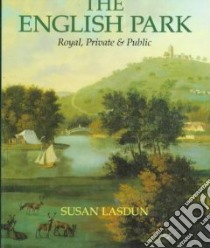The English Park - 9780865651319
Un libro in lingua di Susan Lasdun edito da Harry N Abrams Inc, 1992
- € 26.10
- Il prezzo è variabile in funzione del cambio della valuta d’origine
As scenery and places of recreation, parks are a vital part of our well-being. Their existence is almost taken for granted, yet they are often threatened as they suffer from pressures applied by conflicting interests. The English Park: Royal, Private and Public follows their long history and makes a case for the continued care of this tradition both in the preservation of existing parks and the creation of new ones in our cities.
Parks have been an inseparable part of British lifestyle for nearly a thousand years. Sir Francis Bacon wrote that "Nothing so refreshes a man's spirit as a garden. Buildings and Palaces without a garden are but Grosse Handy-works." For visitors to Britain, the English park is a delight, be it a refreshing oasis in the middle of London or the large, formal garden of a great country house set in the middle of an emerald forest. In this beautifully illustrated book, the first major study of the subject, we see the development of the park from ancient times until the present day.
In classical Greece, parks were generally gymnasia, and in the early middle ages a sort of auxiliary farm where fish were grown in ponds and game husbanded for the chase. By the late middle ages hunting had become a highly ritualized sport, closely linked with chivalry, and solemn pageants were acted out on the meadows and in forests. In the sixteenth century, after the Tudors brought relative peace to the greater part of England, the rich, landed aristocracy started building magnificent places - Hampton Court, Longleat, Penshurst Place, Richmond Palace - and first conceived of the park as an embellishment to architecture. Walks became a major feature of gardens and parks, as exercise and the contemplation of nature were added to the joys of the chase. Thanks to Le Notres formal and ceremonial garden at Versailles, by the late 17th century waterworks and follies attempted to subdue nature by art and the garden and park competed with the palace as an expression of the genius of architect and decorator. The 18th century was the age of Capability Brown, Sir John Vanburgh, William Kent and Joseph Addison, an era of triumph for the English Park, marked by the emergence of the giardino inglese or Englische Garten throughout Europe. Lovely pavilions for pleasure were put up in landscapes so subtly controlled that they seemed absolutely natural, and this period saw the creation of the great parks of London; Hyde Park, Kensington Gardens, St. James and Richmond Parks, as well as Regents Park. The pleasure of the aristocracy was brought to the people and the impetus in gardening switched from the private domain to the public.
To tell this fascinating story, Susan Lasdun draws on many literary sources, in prose and verse, and has sought out remarkable historical documentation as well as delightful and largely unpublished illustrations. This book will appeal to all who seek escape from the pressures of urban life into the bucolic world of the park.
Informazioni bibliografiche
- Titolo del Libro in lingua: The English Park
- Sottotitolo: Royal, Private & Public
- Lingua: English
- Autore: Susan Lasdun
- Editore: Harry N Abrams Inc
- Collana: Harry N Abrams Inc (Hardcover)
- Data di Pubblicazione: 01 Ottobre '92
- Genere: ART
- Argomenti : Parks England
- Dimensioni mm: 247 x 209 x 25
- ISBN-10: 0865651310
- EAN-13: 9780865651319


